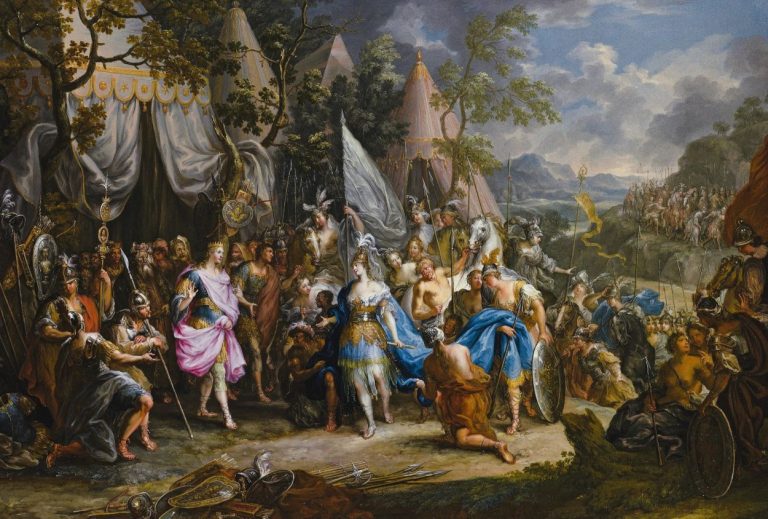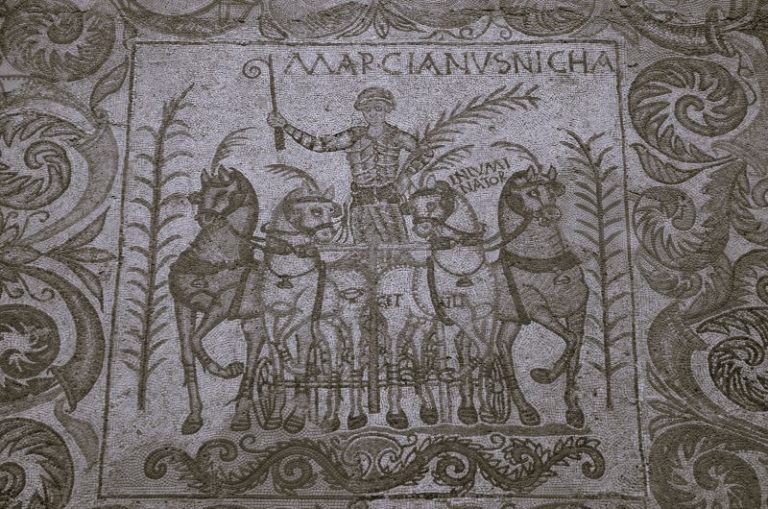
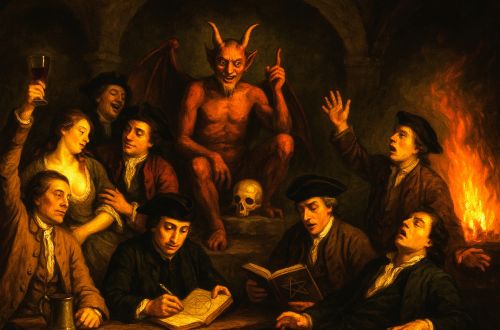
The Hellfire Clubs remain significant not simply because of what their members did, but because of what later generations believed they represented.

By Matthew A. McIntosh
Public Historian
Brewminate
Introduction
Eighteenth century Britain was a landscape of escalating tension between inherited religious authority and new patterns of elite sociability. Aristocrats gathered in private clubs that blended conversation, drinking, performance, and political maneuvering, often beyond the reach of ecclesiastical or civic discipline. These environments emerged during a period when Anglican influence remained strong but increasingly contested, creating cultural space for experiments in irreverence and performances of wit that pushed against conventional piety.1
Among the many small societies formed during this period, the Hellfire Clubs became the most notorious. Their members appeared to embody the contradictions of Georgian culture. They were wealthy, often politically influential, and educated within classical traditions that celebrated satire and philosophical skepticism. At the same time, they adopted rituals designed to amuse the initiated and unsettle the wider public. These activities circulated in contemporary newspapers such as the London Chronicle and The Public Advertiser, which reported on private gatherings in tones that blended concern, curiosity, and moral judgment.2
Modern scholarship has shown that the clubs were not unified organizations but a loose constellation of groups shaped by local personalities and circumstances. The most famous, associated with Francis Dashwood at Medmenham Abbey, built on earlier models while reflecting the intellectual climate of the Enlightenment. Historians such as Peter Gay and Linda Colley have noted that aristocratic men increasingly used private societies to explore political identity, challenge clerical authority, and cultivate reputations for cosmopolitan sophistication.3 Their activities were often theatrical, sometimes provocative, and always enveloped in layers of secrecy that fueled speculation.
The result was a phenomenon that captured the anxieties of its age. Clergy denounced the clubs as signs of declining faith. Political rivals treated them as symbols of corruption. Newspapers used them to warn readers about the dangers of unchecked privilege. Yet the surviving evidence reveals something more complex than the sensational stories that later defined them. The Hellfire Clubs stood at the intersection of elite rebellion, classical parody, and shifting cultural norms, and their legacy has endured as both a historical curiosity and a lens through which to understand eighteenth century debates about power, morality, and public order.4
Eighteenth Century Britain and the Culture of Elite Transgression
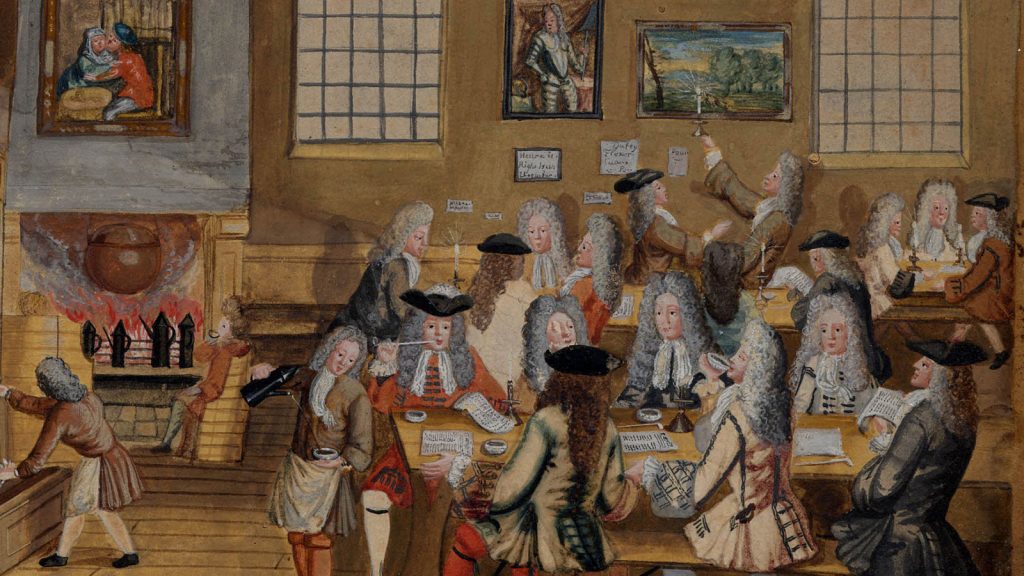
The early eighteenth century marked a period when new forms of elite sociability were reshaping public and private life in Britain. Coffeehouses, clubs, and informal associations multiplied across London and provincial towns, providing spaces where aristocrats experimented with identity and influence outside traditional institutions. These settings drew on earlier Restoration traditions of wit and theatricality, while reflecting a growing sense that status allowed certain men to operate beyond the moral expectations applied to the wider public. Historians have noted that these clubs existed within a culture of expanding literacy, more aggressive journalism, and shifting political alignments that made private gatherings a subject of increasing public scrutiny.5
The established Church remained a powerful institution, yet its authority was increasingly challenged by debates over reason, toleration, and the meanings of Protestant identity. The Enlightenment encouraged a critical stance toward inherited beliefs, and many aristocratic men embraced classical models of intellectual freedom that carried an undercurrent of irreverence.6 The result was an environment in which elite transgression could function as a display of sophistication. The adoption of unconventional rituals, daring humor, or playful blasphemy signaled membership in a cultural world that valued independence from clerical oversight. While few contemporaries doubted the Anglican Church’s formal authority, there was a widening gap between public conformity and private experimentation.
Contemporary newspapers amplified anxieties about these trends. Reports in periodicals such as The London Chronicle, The Public Advertiser, and The North Briton commented on private clubs in ways that blurred fact, rumor, and satire. Press criticism often depicted elite societies as symbols of moral decline or political scheming, reflecting broader concerns about corruption and the erosion of traditional values.7 Georgian readers were particularly attuned to stories in which privilege seemed to escape accountability, and the idea of secret gatherings among the wealthy reinforced fears that established hierarchies were being undermined from within.
Within this context, the Hellfire Clubs emerged as a distinctive expression of aristocratic self-fashioning. Their members combined elements of Enlightenment skepticism, classical parody, and a desire to cultivate exclusivity. These groups did not operate in isolation from mainstream society but interacted with it through newspapers, political networks, and informal channels of influence. Their notoriety grew because they represented something unsettling to many observers. They embodied both the freedoms and the excesses of eighteenth century elite culture, and their existence revealed the tensions between public moral expectation and private aristocratic performance.8
Origins of the Hellfire Club Phenomenon

The first Hellfire Club emerged not in the middle of the century but in the 1720s, when Philip, Duke of Wharton, established a small society that blended satire, political commentary, and libertine display. Wharton was already known for shifting political loyalties and an appetite for public spectacle. His club reflected these traits. It mocked religious conventions, used playful irreverence as a social marker, and provided a stage on which aristocratic men could perform identities that would have been inappropriate in more formal settings. Contemporary sources, including critical pieces in The Craftsman, portrayed Wharton as both a political opportunist and a figure fascinated by theatrical provocation.9
This early club was connected to broader currents in Georgian culture. The Restoration era had produced a tradition of masculine sociability that prized wit, expressive freedom, and the cultivation of elite networks outside the courtroom, Parliament, or Church. Theatrical spaces, masquerades, and private assemblies encouraged experimentation with persona and encouraged a kind of performative excess.10 Wharton’s circle participated in this world, turning parody into both entertainment and a tool for cultivating exclusivity. Although the surviving documentation is limited, the available evidence suggests that the club’s activities relied heavily on satire rather than on the elaborate ceremonies later attributed to Hellfire groups.
The public reaction to Wharton’s club helped shape the mythology that would surround later societies. Newspapers and pamphlets frequently exaggerated the club’s activities for effect. Charges of impiety, immorality, and clandestine behavior appeared regularly, even when based more on rumor than on documented events.11 The combination of aristocratic secrecy, political affiliations, and religious parody provided fertile ground for speculation, and critics used these stories to comment on anxieties about social decay and elite corruption. Such portrayals reveal more about eighteenth century fears than they do about the club’s internal practices, but they nonetheless contributed significantly to the symbolic power of the Hellfire name.
The influence of Wharton’s example extended beyond his own lifetime. His club set a precedent for associational spaces in which political conversation, libertine play, and ritual mockery could coexist. Later figures, including Francis Dashwood, would draw on aspects of this model while establishing their own societies shaped by different intellectual and social priorities. The early Hellfire Club demonstrated that a small group of aristocrats, using parody and secrecy, could capture the imagination of critics and supporters alike.12
Francis Dashwood and the Order of the Friars of St. Francis of Wycombe
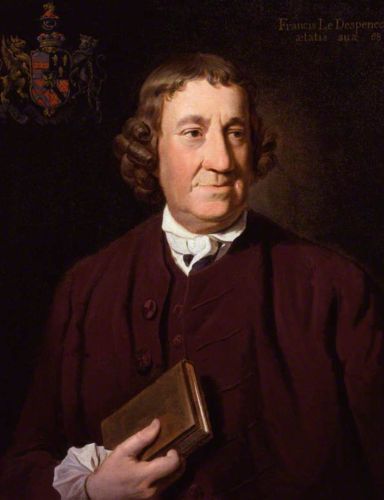
Francis Dashwood reshaped the Hellfire phenomenon more profoundly than any of his predecessors. Born into wealth and educated through extensive travel on the Continent, he cultivated a reputation for classical learning, artistic patronage, and political ambition. His exposure to antiquities, European monastic architecture, and Enlightenment intellectual circles informed the tone of the society he later founded at Medmenham Abbey.13 Rather than reproducing Wharton’s political theatrics, Dashwood created a space where ritual parody, classical allusion, and elite sociability converged in ways that both entertained participants and unsettled observers.
Medmenham Abbey, located along the Thames near West Wycombe, became the center of Dashwood’s activities once he acquired and restored the property in the 1750s. He transformed the site by adopting monastic imagery, commissioning inscriptions in Latin, and designing interior spaces intended to evoke a playful inversion of religious architecture. This setting contributed heavily to the club’s later reputation. While Dashwood’s modifications were documented by antiquarian visitors and later architectural surveys, the most striking elements were grounded in theatrical parody rather than in any evidence of occult practices.14 The physical environment provided an aesthetic frame that blurred satire, sensuality, and private performance, all within a landscape associated with medieval piety.
Dashwood’s circle included several prominent figures in mid eighteenth century politics and culture. John Montagu, Fourth Earl of Sandwich, was among the most visible, although his exact level of participation has been debated. The presence of Benjamin Franklin at West Wycombe is well attested through Franklin’s letters, though scholars note that no reliable primary evidence links him directly to Hellfire rituals.15 What is clear is that Dashwood’s gatherings offered opportunities for conversation, private entertainment, and informal political networking at a time when factional politics were increasingly fluid. These relationships shaped his later career, including his appointments as Postmaster General and briefly as Chancellor of the Exchequer.
Despite its notoriety, the nature of Dashwood’s organization was more ambiguous than later sensational accounts suggest. The group’s internal records have not survived, and much of what is known relies on contemporary commentary, later memoirs, and antiquarian collections. Historians who work with these materials emphasize the need to distinguish verifiable information from nineteenth century embellishment. Evelyn Lord and other scholars have shown that many of the most lurid stories, including claims of structured Satanic worship, originated decades after the group had dissolved and cannot be substantiated through primary evidence.16 Dashwood’s club was certainly irreverent, occasionally provocative, and deeply invested in classical parody, but the available record portrays a society shaped more by wit and performance than by the conspiratorial rituals that later became associated with its legend.
Ritual Parody, Religious Inversion, and Public Anxiety

Ritual parody was central to the identity of the most notorious Hellfire groups. Their use of mock monastic language, classical references, and staged irreverence reflected an intellectual culture that embraced satire as a means of signaling elite education and independence from clerical authority. These performances were designed to amuse a small, closed circle. Contemporary descriptions that can be verified indicate that humor, theatricality, and classical imitation were far more common than any form of structured occult practice.17 Surviving accounts show an interest in lampooning institutional religion through exaggerated ceremony rather than attempting to revive forbidden rites.
At Medmenham Abbey, the symbolic inversion of sacred forms was expressed through architecture and carefully crafted social environments. Latin inscriptions, chamber arrangements modeled loosely on monastic spaces, and decorative programs centered on classical and pastoral themes created an atmosphere in which parody took on a physical dimension. Antiquarian visitors in the late eighteenth century documented these elements, allowing later scholarship to distinguish between verifiable features and later inventions.18 The blending of religious imagery with secular revelry served as a form of elite play, using the weight of ecclesiastical symbolism to heighten the sense of exclusivity and staged irreverence.
Wider public knowledge of these practices came almost entirely through the press, and it was in print that the clubs became objects of fascination and fear. Newspapers like The Connoisseur, The London Chronicle, and The North Briton presented the clubs as symptoms of moral decline, often relying on innuendo rather than direct evidence.19 These articles reflected concerns about the erosion of religious discipline and the growing perception that aristocratic privilege allowed certain men to behave with impunity. The lack of access to the clubs themselves encouraged speculation, and ambiguity invited exaggeration in a media environment that thrived on sensational stories.
Religious authorities responded sharply to reports of irreverence, even when the details were uncertain. Clergymen used the clubs as examples in sermons warning against spiritual apathy and moral corruption. Their criticisms fit into larger anxieties about deism, skepticism, and perceived threats to Protestant orthodoxy.20 Because the clubs operated privately and left few written records, public commentary focused on symbolic danger rather than documented acts. The idea that elite men might parody sacred rituals spoke to broader concerns about disorder at a moment when religion remained central to national identity.
These anxieties helped solidify a narrative in which the Hellfire Clubs stood not simply as eccentric societies but as cultural markers of transgression. Later writers expanded these themes, producing a mythology far removed from the limited evidence available from the eighteenth century. Historians now emphasize that ritual parody was real and significant, but they also note that nineteenth century accounts often projected fears of Satanic experimentation onto groups whose documented activities were grounded in satire.21 The tension between evidence and myth continues to shape interpretations of the clubs’ cultural meaning.
Sexuality, Masculinity, and Elite Privilege
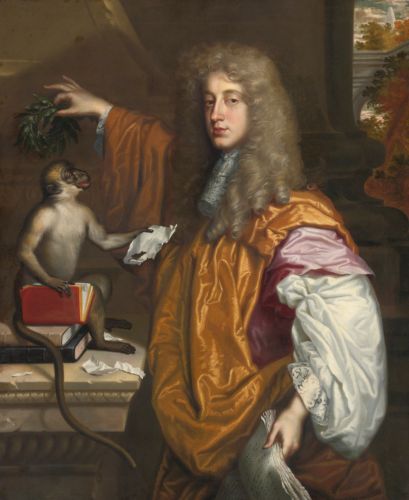
Sexual libertinism played an important role in shaping how contemporaries understood the Hellfire Clubs, but it must be approached through verifiable evidence rather than the sensational tales that later defined their reputation. Georgian elite culture included forms of masculine sociability that permitted degrees of sexual freedom unavailable to most of the population, and club environments often relied on this context. The surviving primary reports describe private gatherings in which elite men performed identities built around wit, worldliness, and a self-conscious distance from conventional morality. Modern scholarship situates these activities within the larger history of libertine behavior rather than within the exaggerated narratives that gained circulation in the nineteenth century.22
Within these settings, sexuality functioned as both entertainment and a marker of privilege. The ability to transgress social norms without facing serious consequences reinforced distinctions between the aristocracy and the wider public. Scholars have shown that eighteenth century attitudes toward sexual conduct varied sharply along class lines, with elite men afforded far greater freedom than women or individuals of lower status.23 The clubs drew on this hierarchy by creating private spaces in which participants could cultivate reputations for daring behavior. These performances were carefully separated from public life, where expectations of decorum and religious conformity persisted.
Accounts of masquerades and private assemblies reveal how anonymity and theatrical roles shaped experiences of desire and amusement among aristocratic men. These elements appear in descriptions of club culture across the period, though reliable sources for the Hellfire Clubs specifically are limited.24 In the absence of direct documentation, historians rely on verified reports of related elite practices to contextualize the clubs’ atmosphere. The connection between performance, sexuality, and social power formed a recognizable pattern in Georgian society, and Hellfire groups operated within this broader matrix rather than outside it.
Women occasionally appeared in discussions of the clubs, but their roles are difficult to reconstruct with precision. Newspaper commentary often hinted at clandestine encounters or scandalous entertainment, yet such claims cannot be substantiated beyond the general observation that elite libertine circles sometimes included female performers or companions.25 Scholarly caution remains essential, since many later accounts projected Victorian anxieties backward onto eighteenth century contexts, transforming unverified rumor into elaborate stories of exploitation. The existing evidence allows historians to speak confidently about gendered privilege and libertine performance, but not about the detailed scenarios that appear in later sensational literature.
In recognizing these limitations, scholars emphasize that sexuality within the Hellfire phenomenon is best understood as part of a larger discussion about masculinity and power. Displays of erotic freedom served to reinforce group cohesion and distinguish members from the constraints that applied to ordinary subjects.26 These dynamics illuminate the cultural setting in which the clubs operated, revealing how aristocratic men used performances of desire to articulate identities grounded in exclusivity, intellectual play, and social dominance.
Politics, Power, and Opposition Culture

Hellfire societies occupied a political landscape in which factional loyalties were shifting, ministries were unstable, and informal networks often mattered as much as formal offices. Aristocratic clubs provided spaces where political conversation could unfold without the constraints of parliamentary decorum or public accountability. In this environment, Dashwood’s circle became part of a broader pattern in which elite men used private sociability to cultivate alliances, test ideas, and strengthen reputations. Their meetings were not organized around a coherent political program, but the participants belonged to overlapping networks that shaped policy debates and influenced appointments. These activities reflected a political culture that valued personal connection and performance as much as institutional authority.27
The broader associational world of Georgian Britain helps explain why political observers paid close attention to the clubs. Historians have noted that the eighteenth century saw the rapid expansion of voluntary societies, coffeehouse circles, debating clubs, and informal gatherings that blurred the boundaries between private and public life.28 Newspapers monitored these spaces because they offered insight into shifting loyalties within the aristocracy. When figures like Dashwood or Montagu appeared in satirical commentary, it signaled that their private reputations were becoming part of wider political narratives. The secrecy surrounding certain gatherings only heightened the sense that they might serve as venues for covert discussions or factional maneuvering.
Contemporary political writers sometimes treated the Hellfire Clubs as symbols of corruption rather than as concrete political threats. Pamphleteers accused prominent members of engaging in activities that demonstrated moral unfitness for public office, even when the accusations lacked evidence. These attacks relied on the assumption that private behavior reflected public character, a theme that gained traction among critics of elite excess. Parliamentary debates occasionally referenced the reputations of certain individuals, though official proceedings did not document any direct legislative response to the clubs themselves.29 The connection between notoriety and political vulnerability meant that the clubs played a role in shaping perceptions even when their internal discussions remain undocumented.
For Dashwood personally, the line between private sociability and public responsibility was especially delicate. His brief tenure as Chancellor of the Exchequer, widely criticized at the time, invited renewed scrutiny of his associations.30 Critics used his participation in the Medmenham circle to frame him as frivolous or lacking seriousness, drawing on widely circulated rumors rather than demonstrated misconduct. Franklin’s visits to West Wycombe added another layer of interest, though verified sources do not support the idea that he participated in ritual activities. The political meaning of these relationships was less about shared policy goals and more about the optics of proximity among influential men at a moment of intense imperial competition and domestic instability.
The intersection of politics and performance within Hellfire culture underscores how fragile aristocratic authority could appear when exposed to public discourse. While the clubs did not operate as organized political fraternities, their members were deeply embedded in the structures of governance, and their private amusements were easily recast as evidence of moral decay or factional intrigue.31 The tension between elite privilege and public responsibility became central to how contemporaries interpreted the phenomenon. The clubs demonstrated both the reach of political networks and the vulnerability of reputations in an age when print culture played a decisive role in shaping public perception.
Decline, Moral Backlash, and Victorian Myth-Making

By the 1760s, the activities associated with Hellfire societies began to fade, due in part to changing political circumstances and the personal trajectories of their most prominent members. Dashwood’s increasing involvement in government, combined with shifting alliances among his circle, left less time and space for private gatherings that had always relied on a delicate balance of secrecy and leisure.32 Some members redirected their attention to parliamentary responsibilities or diplomatic appointments, while others withdrew from public life. As the social networks that sustained the clubs thinned, the groups dissolved quietly, leaving few concrete records of their final years.
This decline coincided with growing public interest in moral reform. Religious leaders and social critics used the image of elite libertinism to argue for a renewed commitment to national virtue. Newspapers amplified these themes by revisiting earlier reports of club activities, often with exaggerated language designed to stir alarm.33 Though the clubs had already diminished, their reputations continued to circulate in print, shaped less by ongoing behavior than by the anxieties of an increasingly moralizing public sphere. The notion that aristocratic vice threatened the stability of the nation became a powerful rhetorical tool.
Eighteenth century writers who criticized the clubs focused largely on moral transgression and class privilege. By the early nineteenth century, however, the narrative shifted as Victorian commentators imported themes drawn from Gothic literature, occult revivalism, and fascination with hidden societies.34 This transformation did not rely on new evidence. Instead, it reflected a cultural climate that associated secrecy with danger and imagined the past as a repository of forbidden rites. The clubs became symbols within a wider mythology that used dark imagery to explore fears about corruption and decline.
Victorian antiquarians contributed significantly to the spread of these embellished interpretations. Some compiled collections of anecdotal material that blended documented references with speculation or rumor, presenting composite narratives that appeared authoritative despite lacking primary foundations.35 These works had lasting influence because they were framed as historical accounts rather than fictionalized stories. Later readers encountered them as factual summaries, reinforcing misconceptions that continue to distort popular understanding of the clubs today.
Modern historians have worked carefully to dismantle the myths that accumulated during the nineteenth century. Scholars have demonstrated the absence of primary evidence supporting claims of organized Satanic worship or structured occult ritual.36 The contrast between verifiable documentation and Victorian elaboration highlights how easily cultural fears can reshape the historical record. By interrogating the origins of these myths, historians reveal the mechanisms through which moral panic and sensationalism alter public memory.
Despite the challenges posed by mythmaking, the legacy of the Hellfire Clubs persists because they embody a complex interplay between fact and imagination. Their documented practices illuminate tensions within eighteenth century society, while the narratives constructed around them reflect later concerns about authority, morality, and secrecy.37 The endurance of these stories speaks to the cultural power of transgressive imagery and to the ways in which the past is continually reinterpreted.
Conclusion: Libertinism, Myth, and Historical Memory
The Hellfire Clubs occupy a distinctive place in the cultural history of eighteenth century Britain because they illuminate the tensions between public morality and private aristocratic performance. Their documented activities reveal a world shaped by satire, classical reference, and a desire to challenge clerical and social expectations. While their rituals created a sense of exclusivity among participants, they also exposed the fragility of elite authority in a society increasingly attuned to political instability, religious conflict, and expanding print culture.38 The clubs’ appeal to contemporaries lay not in their secrecy alone but in their embodiment of concerns about irreverence and privilege.
Over time, the gap between evidence and imagination grew wider. Nineteenth century writers projected their own fears onto the past, transforming limited primary references into expansive tales of occultism and corruption. These embellishments reveal more about Victorian anxieties than about the clubs themselves.39 The transformation of the Hellfire narrative demonstrates how easily the historical record can be reshaped when documentation is sparse and cultural concerns are intense. In this sense, the clubs became instruments for exploring broader questions about decadence, secrecy, and the moral integrity of the ruling classes.
Modern scholarship has worked carefully to disentangle myth from verifiable fact. By scrutinizing architectural remains, surviving correspondence, period newspapers, and the political careers of members, historians have reconstructed a picture that neither romanticizes nor sensationalizes the clubs. Their findings present the societies as products of elite sociability rather than of occult experimentation.40 The endurance of their reputation, however, underscores how narratives of transgression resonate with later audiences seeking symbols that articulate fears about authority and decline.
The Hellfire Clubs thus remain significant not simply because of what their members did, but because of what later generations believed they represented. Their history demonstrates that the boundary between fact and cultural memory is porous, shaped by shifting political, religious, and moral landscapes.41 The clubs continue to serve as a lens through which historians examine the interplay of performance, privilege, anxiety, and imagination within British society. They remind us that the past is never fixed. It is constructed, contested, and continually reinterpreted as new generations impose their own meanings upon it.
Appendix
Footnotes
- Peter Gay, The Enlightenment: An Interpretation, Vol. 1 (New York: Knopf, 1966), 13–27.
- London Chronicle, various issues, 1750s–1760s; The Public Advertiser, various issues, 1750s–1760s.
- Gay, The Enlightenment, Vol. 2, 45–68; Linda Colley, Britons: Forging the Nation, 1707–1837 (New Haven: Yale University Press, 1992), 54–79.
- Evelyn Lord, The Hellfire Clubs: Sex, Satanism and Secret Societies (New Haven: Yale University Press, 2008), 5–19.
- John Brewer, The Pleasures of the Imagination: English Culture in the Eighteenth Century (New York: Farrar, Straus and Giroux, 1997), 55–84.
- Gay, The Enlightenment, Vol. 1, 113–147.
- London Chronicle, The Public Advertiser, and The North Briton, various issues, 1750s–1760s.
- Lord, The Hellfire Clubs, 20–34.
- Heather McPherson, “Theatrical Riots and Cultural Politics in Eighteenth-Century London,” Theater and Theatricality Vol. 43, No. 3 (Fall 2002), 236-252.
- Vic Gatrell, City of Laughter: Sex and Satire in Eighteenth Century London (London: Atlantic Books, 2006), 103–137.
- The Craftsman, various issues, 1720s; see also contemporary pamphlet attacks collected in the British Library, shelfmark 812.m.14.
- Lord, The Hellfire Clubs, 35–47.
- Lord, The Hellfire Clubs, 48–63.
- Ibid., 64–76; see also Nikolaus Pevsner and David Lloyd, The Buildings of England: Buckinghamshire (New Haven: Yale University Press, 1994), 737–739.
- Benjamin Franklin, The Papers of Benjamin Franklin, ed. Leonard W. Labaree et al., Vols. 5–7 (New Haven: Yale University Press, 1961–1972), various references to visits to West Wycombe; Lord, Hellfire Clubs, 77–82.
- Lord, Hellfire Clubs, 83–95; Stables, Dan. “The Original Hellfire Club: Where British Elites Practiced Pagan Rites and Bacchanalian Orgies.” Fodor’s Travel Guide, September 27, 2002.
- Ronald Paulson, Hogarth: His Life, Art, and Times, (New Haven: Yale University Press, 1971), 345–362.
- Pevsner and Lloyd, The Buildings of England, 737–739.
- The Connoisseur, London Chronicle, and The North Briton, various issues, 1750s–1760s.
- J. A. Sharpe, Instruments of Darkness: Witchcraft in England 1550–1750 (Philadelphia: University of Pennsylvania Press, 1996), 212–223; for clerical commentary, see sermon literature in the British Library’s 18th Century Collection.
- Lord, The Hellfire Clubs, 96–112.
- Faramerz Dabhoiwala, The Origins of Sex: A History of the First Sexual Revolution (New York: Oxford University Press, 2012), 184–207.
- Ibid., 45–78.
- Gatrell, City of Laughter, 231–262.
- Laura Rosenthal, Infamous Commerce: Prostitution in Eighteenth Century British Literature and Culture (Ithaca: Cornell University Press, 2006), 98–123.
- G. J. Barker-Benfield, The Culture of Sensibility: Sex and Society in Eighteenth Century Britain (Chicago: University of Chicago Press, 1992), 201–229.
- John Brewer, The Sinews of Power: War, Money and the English State, 1688–1783 (Cambridge: Harvard University Press, 1989), 96–121.
- Colley, Britons, 102–131; Brewer, The Pleasures of the Imagination, 215–239.
- Parliamentary debates referenced in Cobbett’s Parliamentary History of England, Vols. 15–17 (London: R. Bagshaw, 1806–1820); see also satirical pamphlets in the British Library’s 18th Century Collection.
- Stables, Dan, “The Original Hellfire Club: Where British Elites Practiced Pagan Rites and Bacchanalian Orgies.”
- Lord, The Hellfire Clubs, 113–129.
- Lord, The Hellfire Clubs, 130–142.
- London Chronicle and The Public Advertiser, various issues, 1760s.
- Ronald Hutton, The Triumph of the Moon: A History of Modern Pagan Witchcraft (Oxford: Oxford University Press, 1999), 71–95.
- Charles John Samuel Thompson, The Mysteries and Secrets of Magic (London: Rider, 1927).
- Lord, The Hellfire Clubs, 143–158; Hutton, The Triumph of the Moon, 88–95.
- Sharpe, Instruments of Darkness, 229–241.
- Brewer, The Pleasures of the Imagination, 312–329.
- Hutton, The Triumph of the Moon, 71–95.
- Lord, The Hellfire Clubs, 159–178.
- Sharpe, Instruments of Darkness, 229–241.
Bibliography
- Barker-Benfield, G. J. The Culture of Sensibility: Sex and Society in Eighteenth Century Britain. Chicago: University of Chicago Press, 1992.
- Brewer, John. The Pleasures of the Imagination: English Culture in the Eighteenth Century. New York: Farrar, Straus and Giroux, 1997.
- —-. The Sinews of Power: War, Money and the English State, 1688–1783. Cambridge: Harvard University Press, 1989.
- Colley, Linda. Britons: Forging the Nation, 1707–1837. New Haven: Yale University Press, 1992.
- The Connoisseur. Various issues, 1750s–1760s.
- Cobbett’s Parliamentary History of England. Vols. 15–17. London: R. Bagshaw, 1806–1820.
- The Craftsman. Various issues, 1720s.
- Dabhoiwala, Faramerz. The Origins of Sex: A History of the First Sexual Revolution. New York: Oxford University Press, 2012.
- Franklin, Benjamin. The Papers of Benjamin Franklin. Edited by Leonard W. Labaree et al. Vols. 5–7. New Haven: Yale University Press, 1961–1972.
- Gatrell, Vic. City of Laughter: Sex and Satire in Eighteenth Century London. London: Atlantic Books, 2006.
- Gay, Peter. The Enlightenment: An Interpretation. Vol. 1. New York: Knopf, 1966.
- —-. The Enlightenment: An Interpretation. Vol. 2. New York: Knopf, 1969.
- Hutton, Ronald. The Triumph of the Moon: A History of Modern Pagan Witchcraft. Oxford: Oxford University Press, 1999.
- London Chronicle. Various issues, 1750s–1760s.
- Lord, Evelyn. The Hellfire Clubs: Sex, Satanism and Secret Societies. New Haven: Yale University Press, 2008.
- McPherson, Heather. “Theatrical Riots and Cultural Politics in Eighteenth-Century London.” Theater and Theatricality Vol. 43, No. 3 (Fall 2002), 236-252.
- Pevsner, Nikolaus, and David Lloyd. The Buildings of England: Buckinghamshire. New Haven: Yale University Press, 1994.
- The Public Advertiser. Various issues, 1750s–1760s.
- Paulson, Ronald. Hogarth: His Life, Art, and Times. New Haven: Yale University Press, 1971.
- The North Briton. Various issues, 1750s–1760s.
- Rosenthal, Laura. Infamous Commerce: Prostitution in Eighteenth Century British Literature and Culture. Ithaca: Cornell University Press, 2006.
- Sharpe, J. A. Instruments of Darkness: Witchcraft in England 1550–1750. Philadelphia: University of Pennsylvania Press, 1996.
- Stables, Dan. “The Original Hellfire Club: Where British Elites Practiced Pagan Rites and Bacchanalian Orgies.” Fodor’s Travel Guide, September 27, 2002.
- Thompson, Charles John Samuel. The Mysteries and Secrets of Magic. London: Rider, 1927.
Originally published by Brewminate, 11.26.2025, under the terms of a Creative Commons Attribution-NonCommercial-NoDerivatives 4.0 International license.
